There is perhaps no component of a guitar’s construction more underappreciated than its bridge…
Yet without it, there would be no way to set the scale-length, the action or the intonation. A guitar would simply be unplayable without it. Because it’s so important, it might be worthwhile to take a look as the vast variety of electric guitar bridge types.
Fixed Vs. Tremolo Bridges
When you are talking about electric guitars, there are two main categories of bridges, fixed bridge systems (also referred to as “hardtails”) and tremolo bridges (vibrato is actually the technically correct term for a rapidly shifting pitch while tremolo is a rapid shift in volume; however, since even the manufacturers of vibrato units use the term tremolo, we will stick with that term).
Within each of these categories, there is an ever evolving variety of styles utilizing different technologies to hit on the perfect combination of form and function.
Fixed or hardtail bridges are an evolution of the type of bridges originally designed for acoustic guitars. They are fixed in place, and in conjunction with a tailpiece, provide an anchor point on the body of the guitar for the ends of the strings.
Tremolo systems combine the functions of a bridge and tailpiece and include a mechanism by which the pitch of the strings can be raised and/or lowered dynamically to enhance a musical passage. One of the all time classic songs demonstrating the tremendous versatility of a tremolo is Van Halen’s Eruption.
The Functions
Whatever type of bridge it is, it must fulfill 3 major functions.
- First, it must raise the action of the string so it does not bottom out against the fretboard or the body of the guitar (Learn more about fret buzz).
- Secondly, it must provide a termination point for the string’s scale length.
A guitar’s scale length is the distance between the front edge of the nut’s slots to the point where the strings contact the bridge saddles. It is calculated by measuring the distance from the front edge of the nut to the 12th fret and then doubling it. Knowing this distance is crucial to tuning and intonation.
- Finally, it must provide some method of fine tuning each string for proper intonation
Additionally, if the bridge is a combination bridge, such as a “wrap-around” style or tremolo, it must also include an anchor point for the strings.
FAQ: Which Types Of Bridge Fit You Best?
Naturally, there are no hard and fast rules for this. Famous jazz guitarist Les Paul, who was not known for playing songs featuring a lot of crazy tremolo, was often seen playing a Gibson Les Paul Recording model with a Bigsby tremolo unit, while Steve Vai, who’s definitely on the other end of the spectrum, has been known, on occasion, to put down his trademark Ibanez Jem in favor of a Les Paul.

In general terms, however, fixed bridges are usually preferred by jazz, blues, country and classical or traditional guitarists, while tremolo bridges are more suited to rock, particularly hard rock and heavy metal.
[1 Of 2] Fixed (Hardtail) Bridge Types
Since fixed bridges have been around for a longer period of time and are generally of simpler construction, there are more variations of this type of bridge than there are of the tremolo type. Since it would be a nearly impossible task to go over every style of hardtail bridge from every manufacturer, we’ll look at the ones you are most likely to encounter.
1. Tune-O-Matic
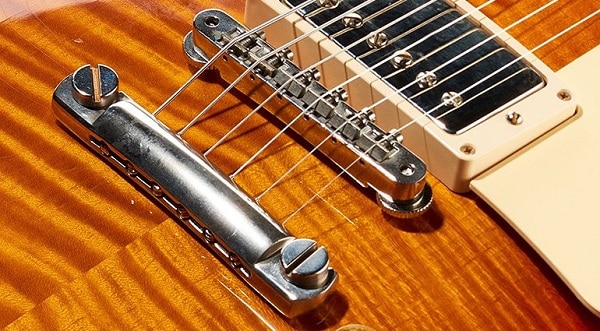
Far and away the most common type of fixed bridge is the Tune-o-matic style bridge. These bridges were originally developed by the Gibson guitar company as a replacement for their wrap around style bridge/tailpiece (original to Les Pauls from 1952-54) to provide more precise adjustment for intonation.
The Tune-o-matic style bridge is mounted on a pair of studs embedded in the body of the guitar. Thumb wheels on the left and right-hand side of the bridge allow for raising or lowering the action on either side. There are also screws along the back of the bridge that allow for individual front to back adjustment of each saddle. These bridges must be used in conjunction with some type of tailpiece, either a stop bar or trapeze-style tailpiece or through body string grommets.
Tune-o-matic saddle intonation and adjustment.
The big advantage of the Tune-o-matic is that is allows for very precise intonation of each string, however, because it is so popular and easily mass manufactured, many poor quality knockoffs are sold that are hard to adjust and don’t hold their intonation.
- Easy raising or lowering of action.
- Fine tuning of saddles for each string.
- Requires separate tailpiece.
- Some 3rd off-brand models are poorly made.
2. Wrap-Around

So called wrap-around bridges have been around since almost the advent of the modern electric guitar. Gibson, Paul Reed Smith, Hamer and dozens of other manufacturers have at some time or another used wrap-around bridges, so called by the way the strings are installed through the front side of the bridge and wrapped around the bridge-tailpiece combo.
It is very popular on lower end guitars for cost and simplicity of manufacture and the fact that it does not require a separate tailpiece to anchor the strings. In its simplest form, a wrap-around bridge is little more than a hunk of metal – usually nickel – with holes drilled in it for the strings to pass through.
Some companies have improved on the original concept by introducing compensated saddles (see image below) which more precisely sets the saddles for better intonation, but still does not allow for adjustment.
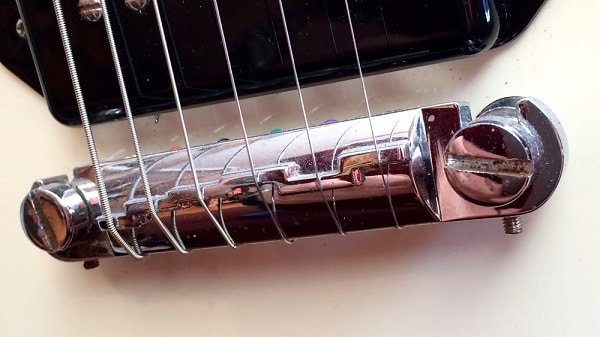
Other manufacturers, like Graph Tech, however, have taken it even further and include adjustable saddles for fine tuning for individual strings.
The biggest disadvantage with the wrap-around tailpiece – at least for those that do not have single string adjustment – is that individual strings cannot be fine tuned and perfect intonation is either very difficult, or impossible.
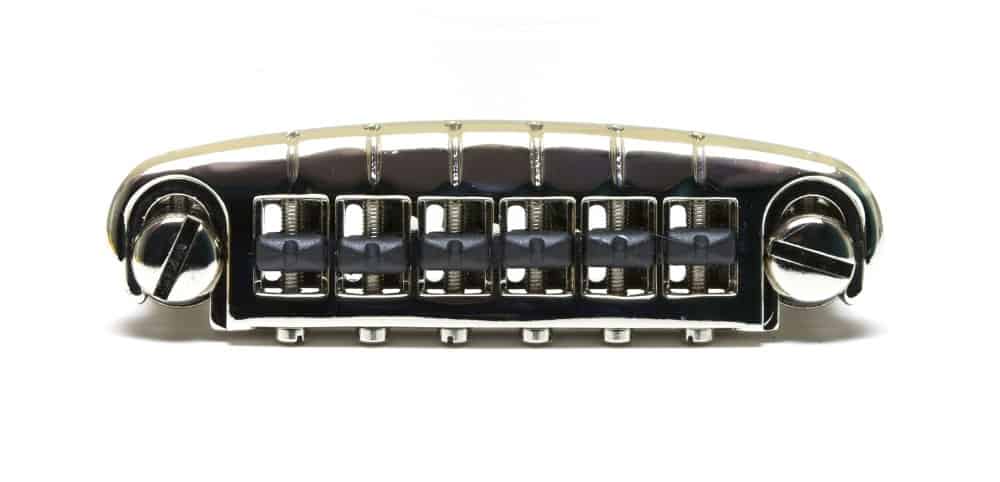
- Cheap and easy to construct
- Good for beginners who are not familiar with setting intonation
- Lack of fine tuning capability in some models
3. Hard-Tail
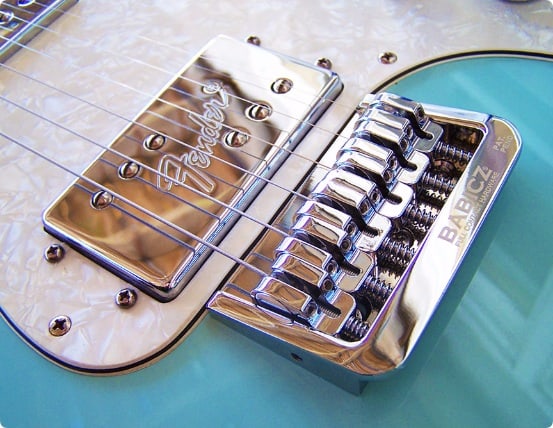
The hardtail bridge has a number of variations, all based on the original non-tremolo Fender Stratocaster. In fact, some enhancements have rendered the similarities between the Fender design and its more modern counterparts almost unrecognizable.
The basic design includes a solid bridge/tailpiece combo with adjustable saddles (up and down and front to back) for each string. Despite the wide variety of configurations and appearances, the method for adjusting the strings is pretty universal. The strings are fed through the back of the bridge and over the saddles which are then adjusted front to back for intonation using slotted screws in the back of the bridge. The action is then set by adjusting small Allen screws in the saddles themselves.
Because of the “floating” nature of the saddles, meaning the saddles are not anchored in place, there can be a tendency, particularly with the cheaper models, to fall out of tune if the player tends to do a lot of string bending. One of the methods sometimes used to remedy this problem is by using roller saddles (see image below) that have less of chance of catching a sting and pulling it out of tune.
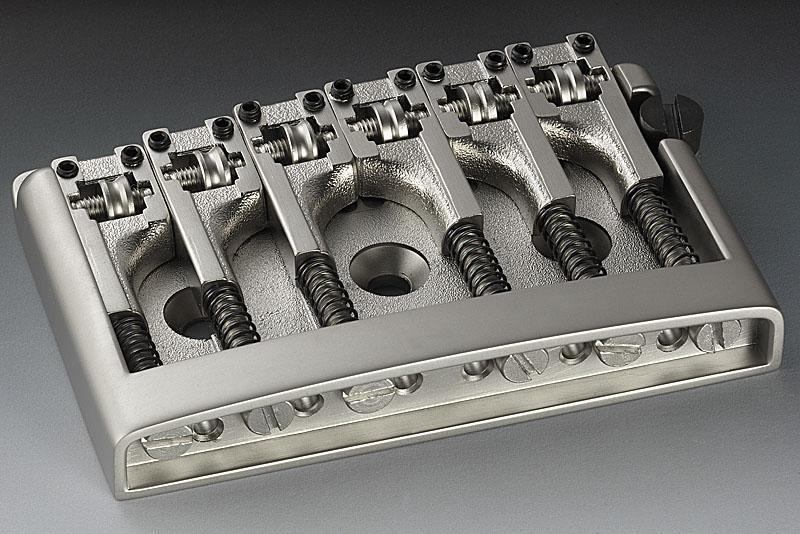
- Fine tuning for each saddle for perfecting intonation
- Can fall out of tune easily depending on quality of manufacture
4. Telecaster

While some of the other bridges we’ve discussed can be used on a number of different guitars, the Telecaster style bridge is designed for one specific application, the Fender Telecaster guitar.
The design of the bridge itself is a variation of the Stratocaster bridge with a couple of differences. First, the original Telecaster bridges (1952-1998) – and the Broadcaster and “Nocaster” that preceded them – had only three saddles so that the strings could only be adjusted in pairs. Newer bridges have six adjustable saddles similar to the Stratocaster.
The most notable difference, however, is the integrated mounting ring for the single coil bridge pickup. Rather than screwing directly into the body of the guitar, the Telecaster bridge pickup is mounted to the bridge assembly with springs allowing the player to adjust the pickup height.
Read More: The Essential List Of Guitar Pickups
Of course the biggest limitations of this bridge are the fact that it is so specialized and potential for adjustment on the older models is limited.
- Provides bridge pickup mounting for Telecaster style guitars
- Only used for Telecaster style guitars
- Older style only allows saddle adjustment in pairs
5. Evertune Bridge
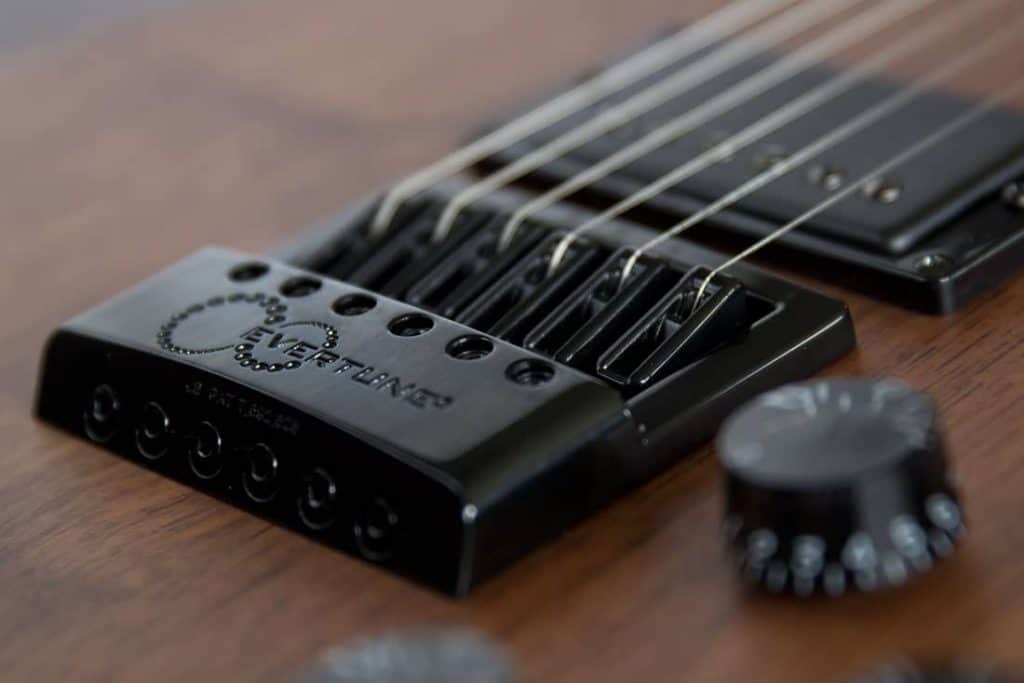
There is a new bridge on the market that has the potential to revolutionize the fixed bridge market. The Evertune bridge is a hardtail style bridge that incorporates a system of springs underneath the saddles that allow them to flex with the movement of the strings to keep the guitar in perfect tune no matter how the strings are bent.
While this is a boon to guitar players, especially metal players who rely on a lot of string bending and vibrato, there are at least two significant drawbacks.
For one thing, the Evertune is a heavy bridge relative to other fixed bridges. The springs and moving parts increase the weight to the point where it feels something like a tremolo bridge. While this might not be a significant factor to most guitarists, the change in balance might take some getting used to.
The other factor is that some significant routing will need to be done to the back of the guitar to fit the additional hardware in. These things need to be taken into consideration before deciding that the advantages are worth the extra work. Here is a demo video of the Evertune bridge.
- Stays in perfect tune when bending strings
- Set and forget tuning and intonation
- Heavy
- Special skills needed to install
- Special skills needed to repair
- Strings can be difficult to install
[2 Of 2] Tremolo Bridge Types
Tremolo bridges allow guitarists to raise or lower the pitch of strings as they play broadening the palette of sounds available to them. Most guitars marketed as “metal” or “hard rock” guitars are equipped with tremolos. As with fixed bridges, the sheer number or tremolo systems prohibits a complete review of every type, but all of the most common models are based on just handful of different design concepts.
Some readers may notice the conspicuous absence of the Bigsby tremolo, but the Bigsby is strictly a tailpiece tremolo and requires an independent bridge to operate. It is, therefore, technically is beyond the scope of this article.
1. Fender Tremolo

The Fender tremolo, first employed on the Stratocaster guitar was the first true tremolo bridge.
The bottom of the bridge rests on a fulcrum allowing the bridge to pivot from front to back. A weighted extension on the rear of the bridge passes through the body of the guitar and is attached to springs mounted in a recessed opening in the back of the body. These springs provide enough tension to counteract the pull of the strings so that the fulcrum sits on a “knife edge”.
Depressing the arm of the tremolo tilts the bridge forward, lowering the pitch of the strings, while pulling back on the arm tilts the bridge back and raises the pitch of the strings.
The Fender tremolo can be difficult to keep in tune with repeated use, despite the use of individual saddles for each string. Check the video below for setting up the fender tremolo bridge.
- Least complex type of tremolo means easier setup
- Fine tuning for each string
- Lack of locking nut and floating fine tuners mean it tends to fall out of tune easily
- Spring loaded action means setup and adjustment takes a lot of time
- Retrofit installations on non-tremolo guitars require special body routing
2. Floyd Rose Style Tremolo
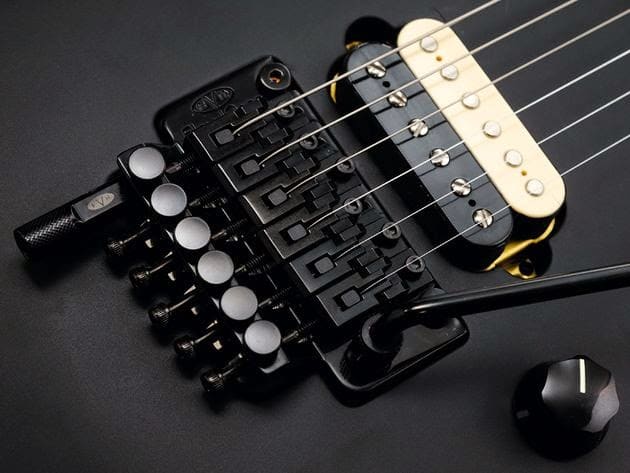
The Floyd Rose tremolo system was based on the Fender model, but was a major upgrade for a number of reasons.
As with the Fender, it operates on a fulcrum design, however, in order to deal with some of the tuning problems encountered on the Fender, the Floyd Rose employs a locking nut to hold the strings in position at the nut so that theoretically the guitar will come back into perfect tune once the tremolo arm is released.
In addition, small thumbscrews are located behind each saddle to lock each string in at the tailpiece, hence the term “double-locking”. This is done to prevent the stings ball ends from sliding out the back when the tension is released.
While the Floyd Rose is a major improvement over the Fender model, there are some significant drawbacks.
- First, if the user wishes for the tremolo to both lower and raise the pitch in retrofit installations, some pretty significant routing will need to be done underneath the bridge to allow for free movement of the system.
- Also, the setup and tuning process tends to be very tedious, requiring many micro-adjustments to get things just right. Check video below for properly setting up a Floyd Rose tremolo.
- Fine tuning for each string
- Double-locking action keeps strings in tune
- Durable and well-made
- Complex installation and setup
- Retrofit installations on non-tremolo guitars require special body routing
3. Kahler Style Tremolo
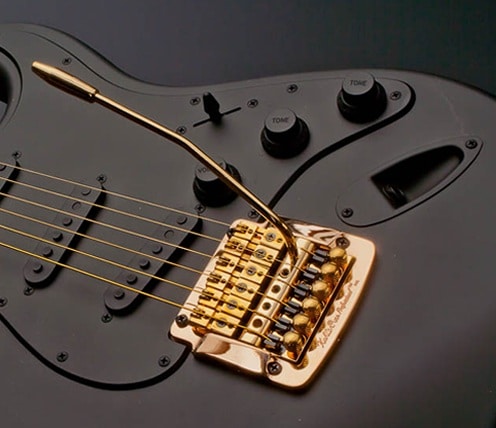
Unlike the Fender and Floyd Rose tremolos, the Kahler system operates on a different principle.
Rather than employ a fulcrum, the Kahler uses a cam arrangement that raises or lowers the tailpiece section of the bridge when the tremolo arm is depressed or raised.
The nicest thing about the Kahler is that it is flush mounted and no special mounting is required to install it. This is especially convenient for someone who wants to install a tremolo unit but lacks specialized tools.
The flush mounting also means that all adjustment mechanisms are easily accessed from the top of the unit, unlike the Floyd Rose or Fender units that require you to access the back of the guitar to adjust the spring tension.

- Fine tuning for each string
- Flush mounting means no routing of the body is required
- Adjustment points are easily accessible from the top of the bridge
- Available only from Kahler USA and authorized dealers
- Not easy to repair
Wrapping It Up
I hope you found this article entertaining and informative and clears up any questions you have regarding the various bridge types available. If you have any remaining questions or comments or if you can think of anything I forgot to add, please feel free to leave your comment below.
As always, keep rocking!